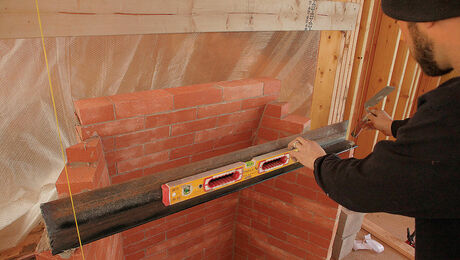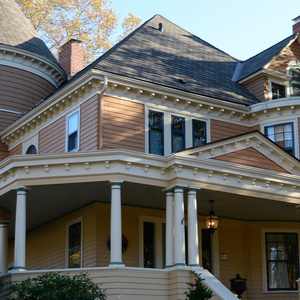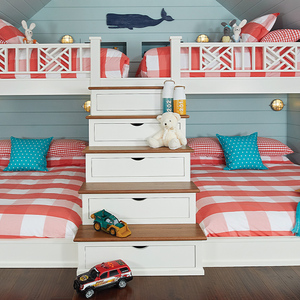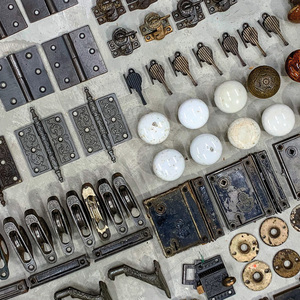How to Run Wiring for Recessed Lights
How should the 12/2 Romex cable be routed in the attic for overhead recessed lights in the living room (single story with lots of attic space)? Can each Romex cable connection for the lights be draped over an adjacent joist and linked in series? Most of the wire would be routed along the joists on the ceiling but the wire would have to be router over at least one joist to make the next connection.
Thanks,
Brian



















Replies
Through the joist, 3/4" hole through the center of the joist. Series is fine.
Mike Hennessy
Pittsburgh, PA
>>single story with lots of attic space)?
He can route the romex over the top of the ceiling joist and fasten it directly to them with staples. The romex also needs to be secured within 12" of each can (easly done with joist at 16"o.c. or trusses at 2' o.c.).
"He can route the romex over the top of the ceiling joist"
True, but when I read "lots of attic space", I was thinking it may be used for storage, etc., now or sometime in the future. So I'd probably drill it.
Mike HennessyPittsburgh, PA
Even then protecting the wire may only mean laying down a 1x on each side of it.
Screw down a 2x4 and staple the wire to the side of it. Standard practice.
2x4 might be standard for new construction, as you have it laying around, but for remodel a 1x3 or 4 is all you need.
to the OP - The wire has to be protected so that you cant crush it be walking on it or sliding stuff over it.
Tu stultus esRebuilding my home in Cypress, CAAlso a CRX fanatic!
Look, just send me to my drawer. This whole talking-to-you thing is like double punishment.
Agree! I almost never have 1x3 or 1x4 but there's always a 2x4 around and it's easy to staple to the side also.
I don't think ANY hole in a joist is a good idea.
I have blown insulation in my attic space but could easily push that aside to use the non-ic type housings. I couldn't find 3" ic housings and trims at the big box stores but I did find the 3" non-ic housing and light (50W GU10 lamp) as an assembly (Utilitech brand). These lights are accent lights for the fireplace wall and would be put about 18" from the wall/fireplace. I can easily get access to the attic and space to put in the lights but the insulation gives me a nasty cough so I would rather not spend a whole lot of time in the attic.
Since this space is over the living room the area around the joists would not be used for storage space, it okay to route the wiring over the joists where needed to move to the next light?
BTW, I had planned to install one light and wire it to the next light, then to the source. I installed some can lights in the room a year ago using that method (they were the 4" ic-type).
Unless you are in a warm climate that you hardly ever heat, you will need to construct an insulated box over the non-ic can meeting the required clearances since the non-ic cans are usually full of holes, it will be like cutting a bunch of holes in your ceiling to let your heat escape. I normally use air-tight ic cans to solve the problem and let me push the cellulose back over them when the installation is done.
Speaking of IC housings....I got some small 3" accent lights for my own house and wasn't even thinking about IC ratings (I got a really good deal). So I get them home then read them...non-ic of course.Then it hit me...coffee can. A full sized coffee can fits around them leaving a 2" air space in on all sides, its metal so not flamable and I can easily seal around it with some spray foam then pile cellulose over that. I haven't done it yet as I am still collecting enough coffee cans - the metal ones are getting rare - but does that sound like a good plan?DC
I've got the same problem and planned on making up some of my own "Coffee cans" with my brake press. You could also use some 7or 8" ducting to make your cans.
Your coffee can idea is good but your going to pee alot. If you need help drinking all that coffee give me a call. No one should regard themselve as "God's gift to man." But rather a mere man whos gifts are from God.
Running the wires over the joists is perfectly OK.
I went to double check that with my Code Check Electical (by Playschool!).
It says that wires need to be protected within 6' of the attic opening.
Tu stultus esRebuilding my home in Cypress, CAAlso a CRX fanatic!
Look, just send me to my drawer. This whole talking-to-you thing is like double punishment.
Unless that "joist" is the bottom chord of a truss roof system. Then that hole would be a BAD idea.
"Unless that "joist" is the bottom chord of a truss roof system. Then that hole would be a BAD idea."
For sure, but then it wouldn't really be a joist.
To the other posters: OK, I give! You can run it over the top.
But I'll still drill.
I just think it's a neater, more professional-looking install. Still, if it's in a crawl space, . . .
Mike HennessyPittsburgh, PA
>>To the other posters: OK, I give! You can run it over the top
Bravo, Mike.
I don't do any residential wiring but do know that speed/ease of installation are big drivers in the economics of residential construction. Although going through the joist would look a lot more proffesional the $$ restraints mean that it would seldom be done.
If the HO in this case wants to drill and pull wire through each joist there is certinly no reason not to. However he didn't sound like he was very comfortable in that environment in the first place, so quick and easy seemed to suite his needs. :>)
BMY,
Is this a new build or a remod?
I would say you are nearly on the right track. However, even though the wire is sent from one light to the next to the next, it is actually wired in parallel within each light using pigtails - usually already attached to the light.
12/2 is heavy for lights, usually 14/2 is used, but it really just has to do with how much demand is on the circuit. How many lights in your circuit? What are the max wattages of each?
Are your lights IC rated? IC=insulation contact. If your lights are not IC rated you will need to devise a way to insulate around them. IC rated is really the best way to go.
If this is a remod situation, I can give a few tips: Layout the locations of the lights on the floor using tape. mark the exact center of each light on the tape. Use a plumb bob (or better, a laser plumb bob) to transfer to the ceiling. Then use a hole saw center drill (no hole saw yet) to drill centers. Have a helper stick a wire (from old coat hanger or something) through the hole as you locate each hole in the attic. Find each hole and remove the insulation around it and make sure you have enough room away from the truss or joist, also make sure there are no wires that you might hit. Now go back down and hole saw the holes (the holesaw will cut through drywall better in reverse). Now you can install your cans. If you have good access in the attic, no reason to use remod lights, use new build lights as they are cheaper and less finicky to install. That's about it.
DC
Would they be controlled with 3 way switches? If so, run 14/3 between the cans... depending on where your power source is... google recessed light wiring diagram or such and you will get several examples
This may be a linguistic problem but NOT series... parallel. In essence, all neutrals are tied together, likewise all hots. In series, one burned out bulb takes out all fixtures (Xmas tree light effect).
PaulB
http://www.makeabettertomorrow.com
http://www.finecontracting.com
There was a big go-round about this here recently. The bottom line seemed to be that the common lingo is fixtures are "run" in series, but "wired" parallel.
FWIW, if someone doesn't know how to wire the fixture's box, s/he shouldn't be doing this project at all.
Mike HennessyPittsburgh, PA